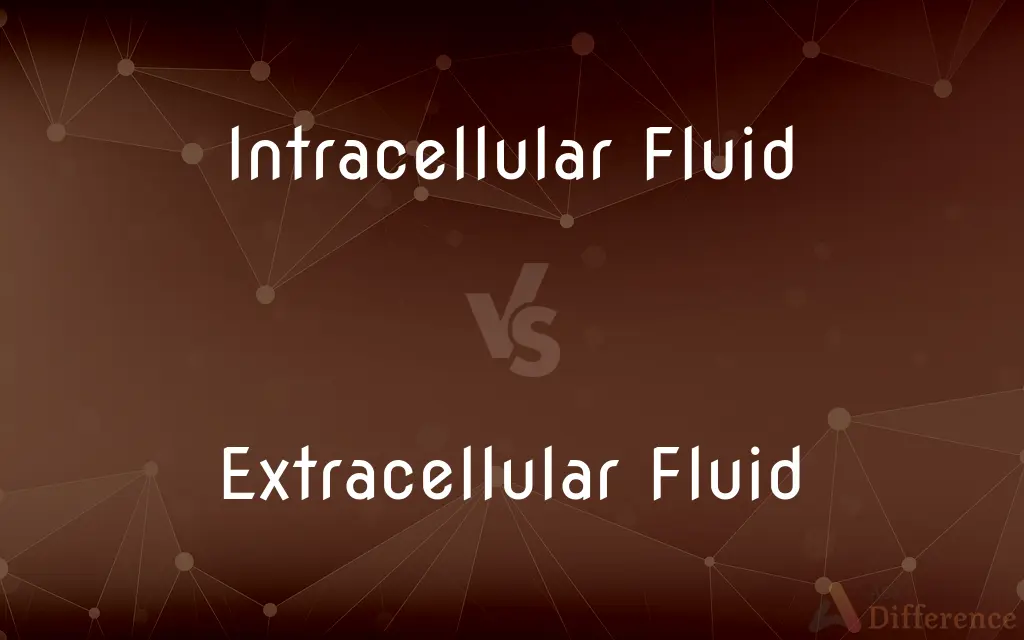Intracellular Fluid vs. Extracellular Fluid — What's the Difference?
Edited by Tayyaba Rehman — By Fiza Rafique — Published on December 4, 2023
Intracellular Fluid is the fluid inside cells, while Extracellular Fluid is the fluid outside cells.

Difference Between Intracellular Fluid and Extracellular Fluid
Table of Contents
ADVERTISEMENT
Key Differences
Intracellular Fluid refers to the liquid found within cells, encompassing about two-thirds of the body's total water content. On the other hand, Extracellular Fluid surrounds the cells and comprises the remaining one-third of the body's water.
The Intracellular Fluid plays a vital role in maintaining cellular function by providing an environment for metabolic processes. Extracellular Fluid, meanwhile, serves as a transport medium, delivering nutrients to cells and carrying away waste.
Electrolyte balance is essential in both fluids. However, the Intracellular Fluid generally contains a higher concentration of potassium ions and lower sodium ions. In contrast, Extracellular Fluid typically has more sodium ions than potassium ions.
The composition of the Intracellular Fluid is critical for processes like cellular respiration, protein synthesis, and waste removal. On the contrary, Extracellular Fluid, which includes blood plasma and interstitial fluid, is pivotal for transporting hormones, nutrients, and waste products between cells and the external environment.
Both Intracellular Fluid and Extracellular Fluid dynamically interact to maintain homeostasis, ensuring the body's internal environment remains stable. While Intracellular Fluid directly influences cellular activities, Extracellular Fluid affects broader physiological processes and responses.
ADVERTISEMENT
Comparison Chart
Location
Inside cells
Outside cells
Proportion of Body Water
About two-thirds
About one-third
Primary Function
Supports cellular metabolic processes
Transports nutrients and waste
Key Ions
Higher potassium, lower sodium
Higher sodium, lower potassium
Components
Cytosol, organelles
Blood plasma, interstitial fluid, lymph
Compare with Definitions
Intracellular Fluid
The fluid contained within cells.
The Intracellular Fluid ensures cells maintain their shape and function.
Extracellular Fluid
Comprises blood plasma, interstitial fluid, and lymph.
The Extracellular Fluid's composition is essential for supporting tissue and organ functions.
Intracellular Fluid
Encompasses about two-thirds of the body's water.
The majority of the body's water resides in the Intracellular Fluid.
Extracellular Fluid
Makes up about one-third of the body's total water content.
Although less voluminous than Intracellular Fluid, Extracellular Fluid plays a vital role in bodily functions.
Intracellular Fluid
Contains a high concentration of potassium ions.
The balance of ions in Intracellular Fluid is essential for maintaining cell membrane potential.
Extracellular Fluid
Contains a higher concentration of sodium ions.
The sodium-potassium pump helps maintain the ion gradient between Intracellular and Extracellular Fluid.
Intracellular Fluid
Provides an environment for cellular metabolic processes.
Without Intracellular Fluid, cellular respiration wouldn't occur efficiently.
Extracellular Fluid
Serves as the transport medium for the body.
Hormones travel through the Extracellular Fluid to reach target cells.
Intracellular Fluid
The medium in which cellular organelles reside.
In the absence of Intracellular Fluid, organelles wouldn't have an optimal environment.
Extracellular Fluid
The fluid located outside of cells.
The Extracellular Fluid helps transport nutrients to cells.
Common Curiosities
Where can you find Extracellular Fluid in the body?
Extracellular Fluid is located outside of cells, including in blood plasma and interstitial spaces.
How does Intracellular Fluid support cellular function?
It provides an environment for metabolic processes, like cellular respiration and protein synthesis.
Which fluid is more abundant in the body?
Intracellular Fluid is more abundant, making up about two-thirds of the body's water.
Which fluid typically has a higher sodium ion concentration?
Extracellular Fluid generally has a higher sodium ion concentration.
What are the main components of Extracellular Fluid?
Extracellular Fluid includes blood plasma, interstitial fluid, and lymph.
What is the primary location of Intracellular Fluid?
Intracellular Fluid is found inside cells.
What role does Intracellular Fluid play in homeostasis?
Intracellular Fluid directly influences cellular activities, helping maintain the body's internal stability.
Which fluid is directly impacted by cellular respiration?
Intracellular Fluid is directly impacted by cellular respiration.
How do these fluids interact with each other?
They dynamically interact to maintain bodily homeostasis.
What can disrupt the balance between Intracellular and Extracellular Fluid?
Factors like dehydration, injury, and certain diseases can disrupt the balance.
Which fluid contains the majority of the body's potassium ions?
Intracellular Fluid contains the majority of the body's potassium ions.
Why is the electrolyte balance important in these fluids?
Electrolyte balance ensures proper cell function, nerve impulses, and muscle contractions.
What essential function does Extracellular Fluid serve?
Extracellular Fluid transports nutrients, hormones, and waste products between cells and the external environment.
Why is Extracellular Fluid essential for tissue function?
It delivers nutrients and oxygen to tissues while removing waste products.
Are changes in Intracellular Fluid volume significant for cell health?
Yes, significant changes in Intracellular Fluid volume can adversely affect cell health and function.
Share Your Discovery

Previous Comparison
Afferent Neurons vs. Efferent Neurons
Next Comparison
Greece vs. RomeAuthor Spotlight
Written by
Fiza RafiqueFiza Rafique is a skilled content writer at AskDifference.com, where she meticulously refines and enhances written pieces. Drawing from her vast editorial expertise, Fiza ensures clarity, accuracy, and precision in every article. Passionate about language, she continually seeks to elevate the quality of content for readers worldwide.
Edited by
Tayyaba RehmanTayyaba Rehman is a distinguished writer, currently serving as a primary contributor to askdifference.com. As a researcher in semantics and etymology, Tayyaba's passion for the complexity of languages and their distinctions has found a perfect home on the platform. Tayyaba delves into the intricacies of language, distinguishing between commonly confused words and phrases, thereby providing clarity for readers worldwide.
















































